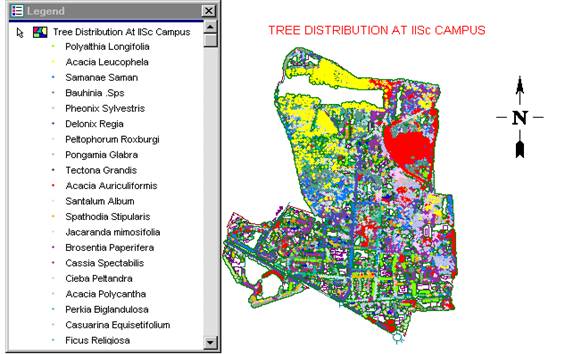Field Investigation :
A detailed field survey was undertaken to map trees (with diameter >10 cm) in the campus. Figure: 2 shows tree distribution in IISc campus. The field investigation gave an idea of the terrain, drainage pattern, vegetation cover and other constraints. Apart from this, a detailed field survey was under taken to map trees in various sub catchments. The drainage network of the campus was also studied to find out the possible problems of channeling the rainwater. The slope of the drains was also noted to delineate the catchment for the Pond. The local problems like blockage, clogging of the drains were also noted, so that remedial actions could be taken.

Figure 2: Tree distribution in IISc campus.
Storm-water pond
Economic and ecological considerations highly favor the creation of a water body inside the campus and divert the storm water generated in the campus to the pond. The water stored in the pond may be used for various purposes such as gardening and for meeting the non-drinking water needs of the adjacent buildings. A small filtration plant near the pond would help in treating the stored water usable for various purposes. A garden may be developed around the pond to enhance the aesthetic appeal. Creation of the water body, apart from providing usable water, is also advantageous from ecological considerations by providing a water source for the number of bird species (about 110 species) that the campus is proud to be a habitat.
The need to conserve water assumes more importance than ever before in the present scenario of water table depletion due to increased demand and over exploitation of groundwater resources. Surface water harvesting has multiple advantages, viz., recharge of ground water and efficient use of rainwater, which otherwise gets wasted or contaminated. This study through spatial and temporal data highlights the parameters to be considered for designing harvesting pond at an appropriate suitable location in the campus. The harvesting pond is designed with a detailed investigation of land use pattern, hydrological analyses, catchment delineation and identification of potential problem areas. The optimal design was arrived at taking into account ecological, economical, social and technical aspects. |